

That Was Then - alisonrhea: devyndelrey: craftandmemory: ... Seven Stones, Louise Bourgeois (Broderie) Louise Bourgeois, L'art est une garantie de santé mentale - Le blog de Annie Penin. Mercredi 2 juin 3 02 /06 /Juin 06:24 J'ai toujours éprouvé une facination pour l'aiguille et son pouvoir magique Louise Bourgeois Une grande artiste de l'art contemporain nous a quitté, Louise Bourgeois est décédée hier.
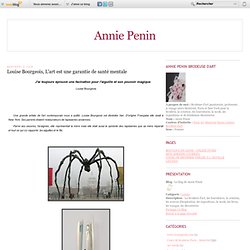
D'origine Française elle vivait à New York. Ses parents étaient restaurateurs de tapisseries anciennes. Parmi ses oeuvres, l'araignée, elle représentait la mère mais elle était aussi le symbole des tapisseries que sa mère réparait et tout ce qui s'y rapporte: les aiguilles et le fils. Quarantania, inspiré des navettes et des instruments de travail de l'atelier de ses parents.
Un lien avec les aiguilles... Le textile était une des matières qu'elle aura exploré, ainsi, à Venise, la fondation italienne Emilio-e-Annabianca-Vedova préparait une exposition d'oeuvres inédites "Louise Bourgeois. Hours of the Day (book cover) A natural cotton cloth book containing 25 hand sewn bound pages printed with archival dyes and hand embroidered, in clothbound case.
Annette Messager par Contemporart. Annette Messager à la galerie Michèle Didier — Critique. 2 - Bien Critique Review December 12, 2012 — By Léa Chauvel-Lévy Annette Messager / Maurizio Nannucci — Ma collection de proverbes / whichever word @ Mfc – Michèle Didier Gallery from November 15, 2012 to January 19, 2013.
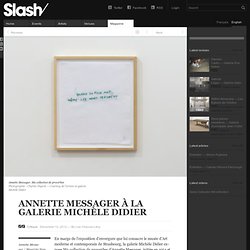
Annette Messager, l’art de la vie. Faire de l’art, c’est truquer le réel Annette Messager Mes Voeux – 1988.

Il était impossible de ne pas parler d’Annette Messager, artiste plasticienne française farfelue, qui représente selon moi toute l’essence de l’art contemporain actuelle…Un temps omniprésent, une entité sexuelle que l’on penne parfois à comprendre, un imaginaire émietté et parsemé de folie, et le corps dans toute son essence et ses questionnements. En bref, Annette Messager mets la vie en scène avec distance, humour et réflexion; le tout hanté par une enfance tourmentée. Jalousie/Love. «On m'a traitée de folle» H' Artpon » Annette Messager. L’univers d’Annette Messager est un univers où les idées sont filantes, et où les projets semblent reliés entre-eux comme des constellations d’étoiles.

La fantaisie de cette artiste l’entraine sur de multiples pistes, mais toujours ses messages se complètent et se font échos, unis par la vocation non dissimulée d’explorer les abymes de la condition féminine. Mes broderies. Sashiko Quilting. To date all of my quilt tops have been sent out to be quilted by a professional on the large commercial quilting machines.
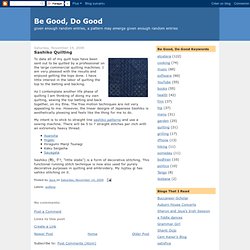
I am very pleased with the results and enjoyed getting the tops done. I have little interest in the labor of quilting the top to the batting and backing. As I contemplate another life phase of quilting I am thinking of doing my own quilting, sewing the top batting and back together, on my Elna. The free motion techniques are not very appealing to me. However, the linear designs of Japanese Sashiko is aesthetically pleasing and feels like the thing for me to do. Sashiko lesson 2. Continued from Sashiko lesson 1 Patterns based on squares, diagonals, diamonds and hexagons These patterns have straight lines, and sharp edges or corners. This lesson will help you to get a feel of how to deal with different kinds of patterns, and how to decide what stitch sequence to follow. Symbolism in Sashiko. A little bit about symbolism in sashiko designs How does symbolism in design happen?
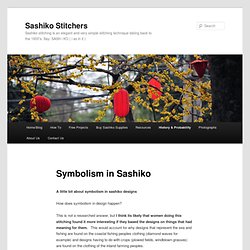
This is not a researched answer, but I think its likely that women doing this stitching found it more interesting if they based the designs on things that had meaning for them. This would account for why designs that represent the sea and fishing are found on the coastal fishing peoples clothing (diamond waves for example) and designs having to do with crops (plowed fields, windblown grasses) are found on the clothing of the inland farming peoples.
As well as designs symbolizing the natural world and the work their men did, there are the designs that I think come from the domestic cares and work of the women themselves: rice box and steam rising for kitchen work for instance, or tortoise shell as a symbol for good fortune and long life, hemp leaf as a symbol for strong health and bamboo as a symbol for vitality and prosperity. A note: There is also a category of design called mons. Www.athreadedneedle.com. LetterandLine: I exist too. Sashiko. This is a compilation of QUILTNET postings about Sashiko.
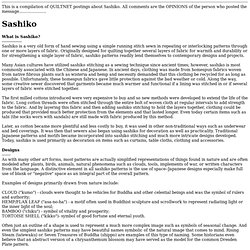
All comments are the OPINIONS of the person who posted the message...................... What is Sashiko? ---------------- Sashiko is a very old form of hand sewing using a simple running stitch sewn in repeating or interlocking patterns through one or more layers of fabric. Originally designed for quilting together several layers of fabric for warmth and durability or for strengthening a single layer of fabric, sashiko patterns readily lend themselves to contemporary designs and projects.
Many Asian cultures have utilized sashiko stitching as a sewing technique since ancient times; however, sashiko is most commonly associated with the Chinese and Japanese. The first milled cottons introduced were very expensive to buy and so new methods were developed to extend the life of the fabric. Later, as cotton became more plentiful and less costly to buy, it was used in other non-traditional ways such as underwear and bed coverings.
Digital Sashiko papers Blue Indigo Digital by ValerianeDigital. University of Michigan. October 13, 2001 - January 6, 2002 West Gallery Coat (sashiko no donza) From Tonouchi, Hokudan-chô, Awaji Island First half of 20th century Made by Hashimoto Yuu (1879?
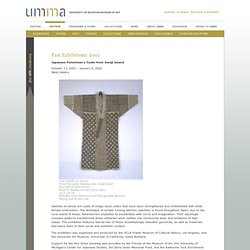
-1963) 133 x 126 cm Hokudan Town Historical and Ethnographic Museum Photograph by Don Cole Sashiko no donza are coats of indigo-dyed cotton that have been strengthened and embellished with white thread embroidery. The technique of simple running stitches (sashiko) is found throughout Japan, but on the rural island of Awaji, fisherwomen exploited its possibilities with verve and imagination. Their dazzlingly complex patterns transformed these utilitarian work clothes into ceremonial wear and emblems of high status. The exhibition was organized and produced by the UCLA Fowler Museum of Cultural History, Los Angeles, and the University Art Museum, University of California, Santa Barbara.
The Project. Laws of Simplicity. Bookbinding - japanese style Part 1. Sashiko.